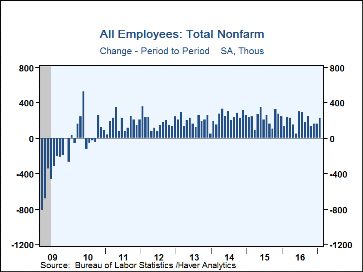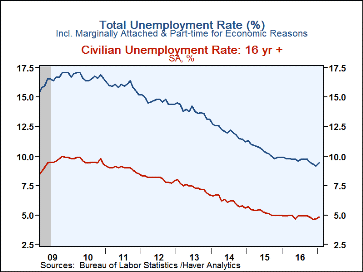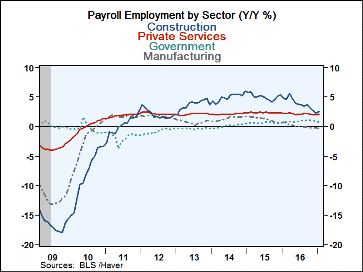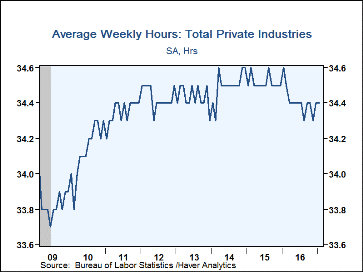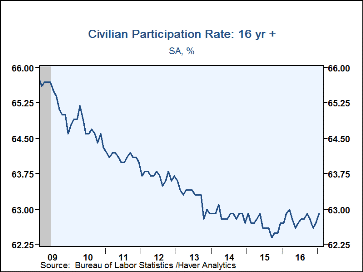 Global| Feb 03 2017
Global| Feb 03 2017U.S. Payroll Increase Accelerates; Wage Gains Slow
by:Tom Moeller
|in:Economy in Brief
Summary
The job market started the new year on a firm footing. Nonfarm payroll employment increased 227,000 (1.5% y/y) following increases of 157,000 and 164,000, previously reported as 156,000 and 204,000. The latest gain was the strongest [...]
The job market started the new year on a firm footing. Nonfarm payroll employment increased 227,000 (1.5% y/y) following increases of 157,000 and 164,000, previously reported as 156,000 and 204,000. The latest gain was the strongest since September. Expectations had been for a 175,000 rise in the Action Economics Forecast Survey. Data back to 2012 were revised and added slightly to growth in 2016. Average hourly earnings nudged 0.1% higher (2.5% y/y). The December gain was revised down to 0.2% from 0.4%, but the November figure was revised up. A 0.3% increase had been expected. The unemployment rate increased to 4.8% versus an expected 4.7%. It was the highest rate in three months, up from the November low of 4.6%. The total unemployment rate including marginally attached workers and those working part-time for economic reasons rose to 9.4% from 9.2%.
The 227,000 increase in payroll employment reflected a 5,000 increase (-0.4% y/y) in factory sector employment, as it followed an 11,000 rise. Jobs increased in both the durable & nondurable goods sectors. Construction sector employment strengthened 36,000 (2.6% y/y), the strongest increase since March. Jobs in the mining sector improved 4,900 (-8.1% y/y), but they remained 27.7% below the September 2014 peak.
Private service sector employment increased 192,000 (2.1% y/y), improved from the 139,000 rise averaged during Q4. Retail trade employment strengthened 45,900 (1.5% y/y) after a 33,500 December rise, following declines in the prior two months. Transportation & warehousing employment eased 4,000 (+2.2% y/y). Employment in the professional & business sector increased 39,000 (2.9% y/y), though that remained down from the 84,000 increase during July. Temporary help jobs rose 14,000 (3.3% y/y) following a 12,800 decline. Leisure & hospitality employment increased 34,000 (2.2% y/y), though it rose 79,000 in May of 2015. Health care & social assistance jobs increased 32,000 (2.5% y/y), though again it fell short of the 79,500 rise in April 2015. Financial activity employment jumped 32,000 (2.3% y/y), the strongest increase since October 2005. Information sector employment gained 3,000 (0.1% y/y) after declines in the 7prior three months.
Government sector payrolls fell 10,000 (+0.7% y/y), the fourth straight month of decline. State government jobs were off 9,000 (-0.3% y/y), also the fourth straight monthly shortfall. Local government jobs fell 5,000 (+0.9% y/y), and continued the declines of recent months. Federal government jobs increased 4,000 (1.8% y/y) after a 5,000 rise.
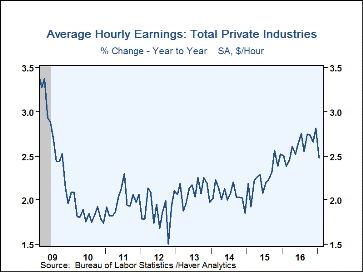 Average hourly earnings in the private sector edged 0.1%
higher. Recent weakness in the monthly figures lowered the y/y gain to 2.5% y/y.
That reversed the recent acceleration to a December high of 2.8% y/y from 2.1%
growth during all of 2014. The shortfall was most notable in the financial
services sector where y/y growth slowed to 0.7% from 2.6% during all of last
year. In most other sectors, earnings growth was fairly stable and firm, notably
in leisure & hospitality where earnings grew 4.2% y/y.
Average hourly earnings in the private sector edged 0.1%
higher. Recent weakness in the monthly figures lowered the y/y gain to 2.5% y/y.
That reversed the recent acceleration to a December high of 2.8% y/y from 2.1%
growth during all of 2014. The shortfall was most notable in the financial
services sector where y/y growth slowed to 0.7% from 2.6% during all of last
year. In most other sectors, earnings growth was fairly stable and firm, notably
in leisure & hospitality where earnings grew 4.2% y/y.
The length of the average workweek held steady m/m at 34.4 hours, lower than the expansion high of 34.6 hours. Aggregate hours worked (employment times hours) increased 0.2% (1.1% y/y), and began the first quarter at the highest level of the economic expansion.
From the household sector employment survey, the higher 4.8% unemployment rate reflected a 458,000 rise (1.3% y/y) in population-adjusted employment and a 586,000 increase (1.1% y/y) in the population-adjusted labor force. The labor force participation rate rose to 62.9%, up from the 62.4% low in September 2015.
By educational attainment, the 7.7% unemployment rate for those without a high school diploma remained up from the expansion low of 6.3%. High school graduates with no college saw the jobless rate tick up m/m to 5.3%, but that was down from 10.3% during all of 2010. Persons with less than a bachelors degree realized a recently steady 3.8% rate of joblessness. Individuals' with a bachelor's degree or higher saw a 2.5% rate of unemployment, stable but below its 2010 high.
The teenage unemployment rose m/m to 15.0%, but was down from 25.9% in 2010. Unemployment amongst 20-24 year olds of 8.3% was below the 15.5% 2010 high. For those over 25 years old, the unemployment rate of 3.9% was down from 8.2% in 2010.
The labor market data are contained in Haver's USECON database. Detailed figures are in the EMPL and LABOR databases. The expectations figure is in the AS1REPNA database.
| Employment: (SA, M/M Change, 000s) | Jan | Dec | Nov | Jan Y/Y | 2016 | 2015 | 2014 |
|---|---|---|---|---|---|---|---|
| Payroll Employment | 227 | 157 | 164 | 1.5% | 1.7% | 2.1% | 1.9% |
| Previous | -- | 156 | 204 | -- | -- | -- | -- |
| Manufacturing | 5 | 11 | 0 | -0.4 | -0.2 | 1.1 | 1.4 |
| Construction | 36 | 2 | 28 | 2.6 | 3.9 | 5.0 | 5.0 |
| Private Service-Producing | 192 | 150 | 143 | 2.1 | 2.2 | 2.4 | 2.1s |
| Government | -10 | -8 | 6 | 0.7 | 0.6 | 0.6 | 0.1 |
| Average Weekly Hours - Private Sector | 34.4 | 34.4 | 34.3 | 34.6 | 34.4 | 34.5 | 34.5 |
| Private Sector Average Hourly Earnings (%) | 0.1 | 0.2 | 0.0 | 2.5 | 2.6 | 2.3 | 2.1 |
| Unemployment Rate (%) | 4.8 | 4.7 | 4.6 | 4.9 | 4.8 | 5.3 | 6.2 |
Tom Moeller
AuthorMore in Author Profile »Prior to joining Haver Analytics in 2000, Mr. Moeller worked as the Economist at Chancellor Capital Management from 1985 to 1999. There, he developed comprehensive economic forecasts and interpreted economic data for equity and fixed income portfolio managers. Also at Chancellor, Mr. Moeller worked as an equity analyst and was responsible for researching and rating companies in the economically sensitive automobile and housing industries for investment in Chancellor’s equity portfolio. Prior to joining Chancellor, Mr. Moeller was an Economist at Citibank from 1979 to 1984. He also analyzed pricing behavior in the metals industry for the Council on Wage and Price Stability in Washington, D.C. In 1999, Mr. Moeller received the award for most accurate forecast from the Forecasters' Club of New York. From 1990 to 1992 he was President of the New York Association for Business Economists. Mr. Moeller earned an M.B.A. in Finance from Fordham University, where he graduated in 1987. He holds a Bachelor of Arts in Economics from George Washington University.


